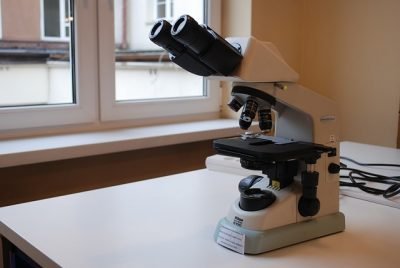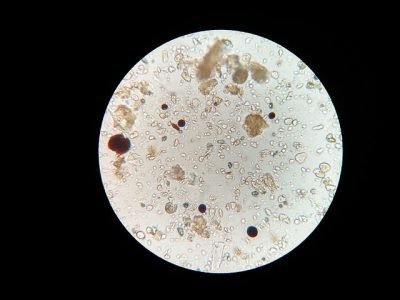 Going into your first microscope purchase can be daunting – the technical jargon alone can be confusing if you’re not specifically aware of what you’re looking for, depending on your needs. Some will cost you as much as buying a car would, and make more sense if you’re going to be using it in a laboratory for high-precision research and study than at home.
Going into your first microscope purchase can be daunting – the technical jargon alone can be confusing if you’re not specifically aware of what you’re looking for, depending on your needs. Some will cost you as much as buying a car would, and make more sense if you’re going to be using it in a laboratory for high-precision research and study than at home.
Fortunately, there are plenty of microscope options on the lower, more affordable end of the scale, whether you’re looking for a toy scope for kids beginning to explore their environment or something a bit more heavy-duty and suited to the seasoned hobbyist or the home-based researcher. To know what best suits your needs, you’ll need to start off securing your understanding of Microscope Basics 101 – which is where we come in.
Compound or Stereo?
 When looking into microscopes for home use, you’ll likely come across scopes classified as either compound, or stereo. Compound or high power microscopes have a broader range of magnification better suited for examining smaller (literally ‘microscopic’) specimens in greater detail – think microorganisms or cell samples, too tiny to see with the naked eye. A compound microscope can come equipped with 3 to 5 objective lenses – objective lenses being the lenses closest to the specimen, which receive the rays reflected off of it to create the image you see through the eyepiece. Magnification of objective lenses can range from 4x to 100x, with more adjustability allowing you to magnify miniscule specimens as you need to get a good look at whatever you’re examining.
When looking into microscopes for home use, you’ll likely come across scopes classified as either compound, or stereo. Compound or high power microscopes have a broader range of magnification better suited for examining smaller (literally ‘microscopic’) specimens in greater detail – think microorganisms or cell samples, too tiny to see with the naked eye. A compound microscope can come equipped with 3 to 5 objective lenses – objective lenses being the lenses closest to the specimen, which receive the rays reflected off of it to create the image you see through the eyepiece. Magnification of objective lenses can range from 4x to 100x, with more adjustability allowing you to magnify miniscule specimens as you need to get a good look at whatever you’re examining.
The eyepiece, which is the lens closest to the user through which you’ll be viewing the specimen, typically comes with the standard magnification of 10x. The total magnification is found by multiplying the magnification of the eyepiece with the objective lens – so, for instance, if you’re using a 10x magnified eyepiece with an objective lens of magnification 100x, the total magnification will be 1,000x.
Stereo microscopes are for bigger specimens, ideal for activities where you need some, but not too much, magnification. If you’re into coin collecting or studying precious stones, fauna or flora, you won’t need as much magnifying power as a compound scope – a stereo scope with a range of 6.5x to 45x magnification will suffice, though there are options with higher magnification ranges if you need one.
Monocular, binocular, trinocular?
As the names suggest, monocular refers to a scope with one eyepiece, binocular refers to a scope with two, and trinocular with three. Compound microscopes are available with all three types of eyepieces, but the application is what determines which is suited to you. Monocular scopes offer magnification up to 1,000x – for higher levels of magnification, you need a binocular option. Binocular scopes have the added benefit of being more ergonomic and comfortable for use by most adults, while also featuring a mechanical stage – this is a mechanism which allows the user to shift the specimen on the stage, to have better control as you study it. If you’re looking out for a microscope primarily to be used by kids, a monocular option is better suited for their closer set eyes. Finally, microscopes with a trinocular port are used for microphotography.
On the contrary, stereo scopes typically come with binocular eyepieces, available in two configurations: dual power, which features two magnification levels, and zoom, which offers more of an adjustable range you can work higher or lower down the available scale. Some stereo scopes are also available with a trinocular port for microphotography.
This doesn’t mean they’re the only exclusive types of microscopes, though. Of late digital microscopes, compatible with laptops and phones, have also risen in popularity.
Achromatic, Semi-Plan, Plan?
 The most common type of objective lens you’ll find for a home microscope is an achromatic lens – these lenses are color-correcting, working to correct the differences in refraction of different colors as they travel at different angles through curved glass. This works to flatten the image you see through the eye-piece.
The most common type of objective lens you’ll find for a home microscope is an achromatic lens – these lenses are color-correcting, working to correct the differences in refraction of different colors as they travel at different angles through curved glass. This works to flatten the image you see through the eye-piece.
Achromatic lens standards provide for a central 60% of the field of view to be free of aberrations (defects distorting the rendering of a precise image of the specimen) – when looking through the eyepiece, the outer 40% will appear to curve out of focus. Don’t worry – this doesn’t affect the accuracy of your microscope, since what you’ll be focusing on will fall within the central 60% of the field of view anyway.
For a home microscope, picking lenses 100% free of aberrations (called ‘plan achromatic’) or with at least 80% of the field of view free of aberrations (called ‘semi-plan achromatic’), may be an overkill because these types tend to be much more expensive and better suited for use in specialized environments.
Another aspect of objective lenses to look out for is the ‘Deutsche Industrie Norm’ or ‘DIN’ – this is an international standard for microscopic objective lenses, which essentially ensures that if you damage one of your lenses, you’ll be able to purchase a replacement from any manufacturer producing DIN-compliant lenses.
Lighting
For most entry-level microscopes, you’ll find tungsten or incandescent light as the primary lighting source. Though inexpensive, the yellowish cast of the light can alter the accuracy of the specimen image. If you’re using the microscope for research or studies, energy-efficient and more color-friendly LED lights are a better option.
For more specialist applications, you’ll want to look for microscopes compatible with fluorescent or halogen lighting. White fluorescent lighting, which doesn’t emit too much heat, is often used as additional lighting in conjunction with stereo microscopes. For scientific applications, including in the medical field, the bright and concentrated beam of halogen light works better with microscopes needed for such applications.
In terms of lighting, another factor you might want to look into is an iris diaphragm – these are typically found with high power compound scopes, a five-hole disk under the stage which lets you alternate the amount of light shining through the specimen, giving you control over contrast and resolution. Combined with an Abbe condenser, a lens which moves vertically, mounted under the stage, you can control the diameter and focal point of light running through the stage and the specimen, in turn giving you control over the concentration of light so you can adjust for focus and accuracy.